AH21 Final Guide
4.6(12)
4.6(12)
Card Sorting
1/32
Study Analytics
Name | Mastery | Learn | Test | Matching | Spaced |
|---|
No study sessions yet.
33 Terms
1
New cards
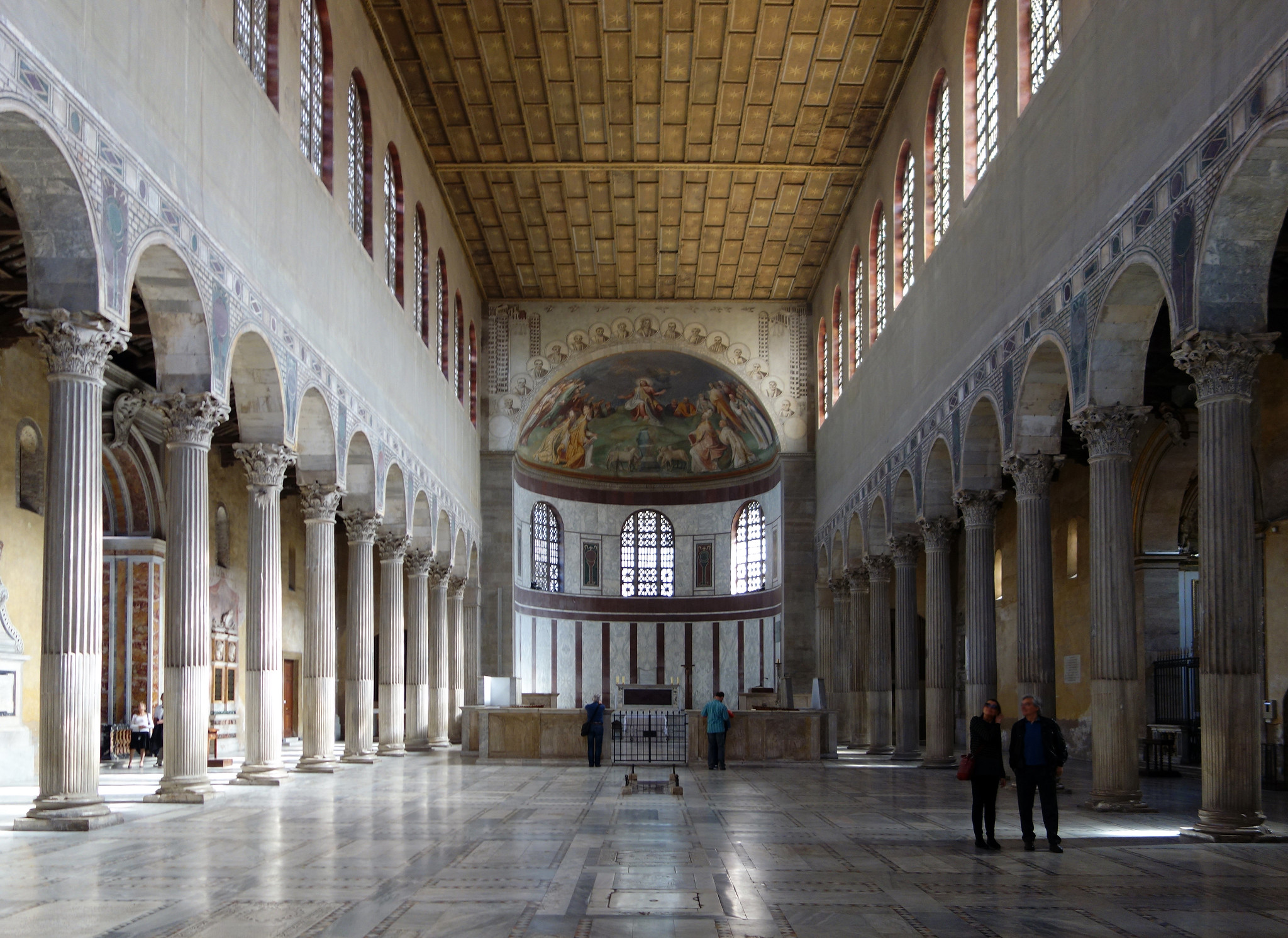
**Name:** Church of Santa Sabina
Era: Early Christian 200-450
**Location:** Rome
**Significance:** Basilica plan + the wooden doors of the church are the earliest display of Christ’s crucifixion
Era: Early Christian 200-450
**Location:** Rome
**Significance:** Basilica plan + the wooden doors of the church are the earliest display of Christ’s crucifixion
2
New cards
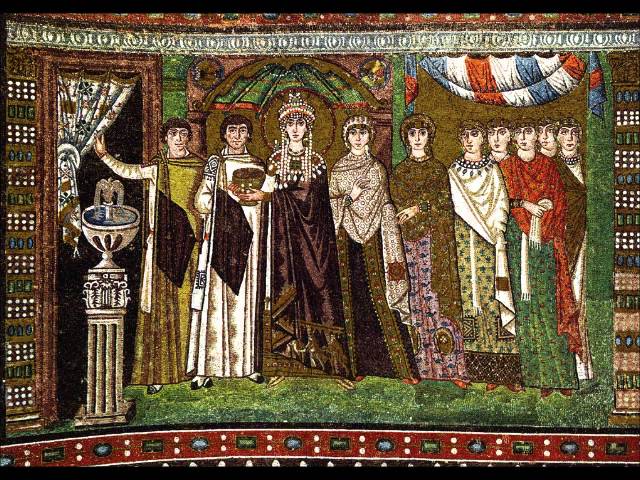
**Name:** Empress Theodora and her Attendants
**Era:** Early Byzantine 300-800
Location: Church of San Vitale, Ravenna
**Patron:** Justinian
**Significance:** depiction of Justinian’s wife and demonstration of a shift in art style -- from 3d to flat 2d
**Era:** Early Byzantine 300-800
Location: Church of San Vitale, Ravenna
**Patron:** Justinian
**Significance:** depiction of Justinian’s wife and demonstration of a shift in art style -- from 3d to flat 2d
3
New cards

**Name:** Hagia Sophia
Era: Early Byzantine 300-800
**Location:** Constantinople (now Istanbul, Turkey)
**Patron:** Justinian
**Architects:** Anthemius of Tralles and Isidore of Miletus
**Significance:** A space believed to transport individuals from a physical to a spiritual realm (temporal disruption). Centrally planned building
Era: Early Byzantine 300-800
**Location:** Constantinople (now Istanbul, Turkey)
**Patron:** Justinian
**Architects:** Anthemius of Tralles and Isidore of Miletus
**Significance:** A space believed to transport individuals from a physical to a spiritual realm (temporal disruption). Centrally planned building
4
New cards
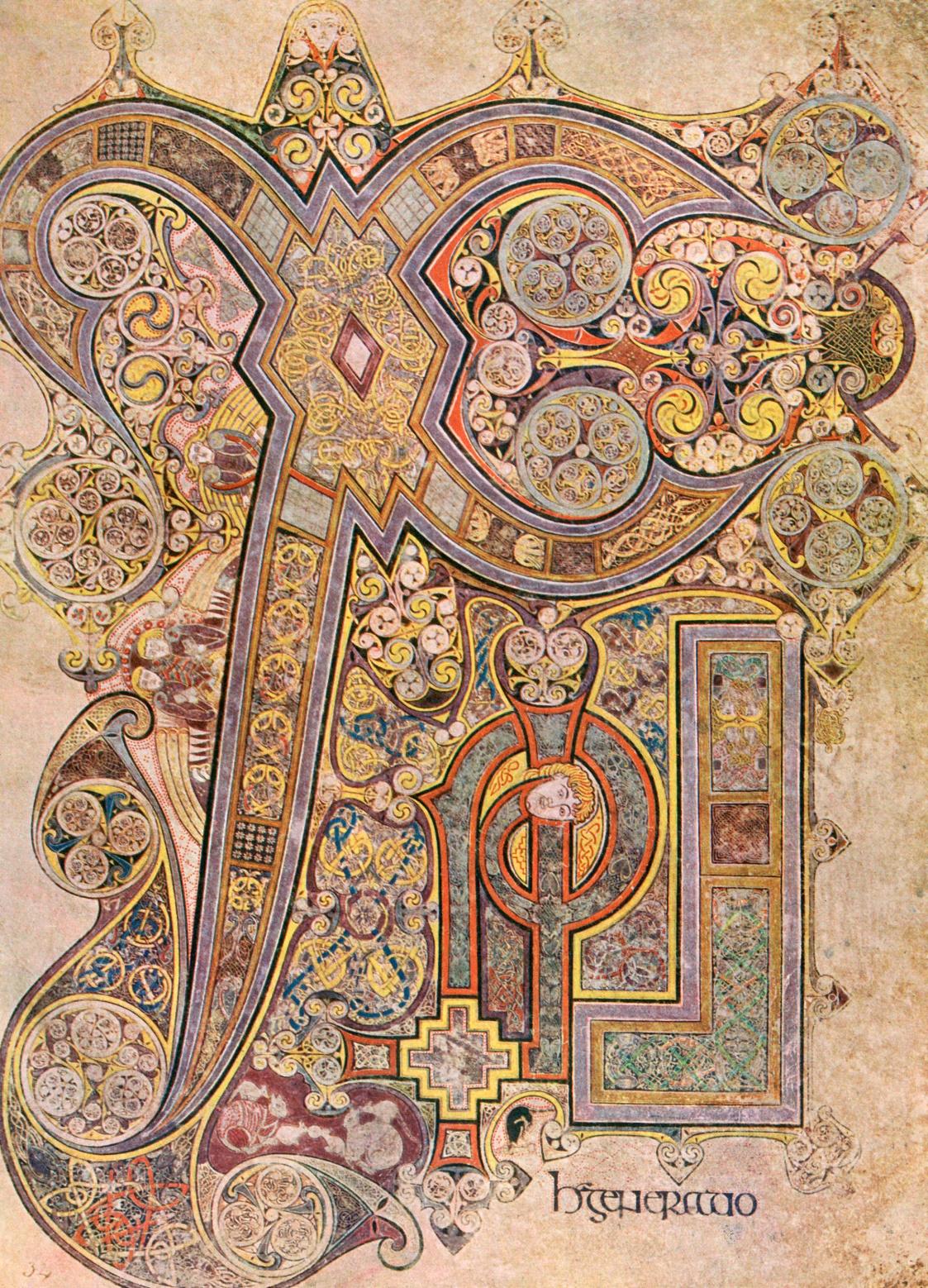
**Name:** Chi Rho Iota page, Book of Kells
**Era:** Insular 450-650
Location: British Isles
**Significance:** the most complex insular gospel. Has interlace and zoomorphic imagery. It is also evidence of the spread of Christianity throughout Europe
**Era:** Insular 450-650
Location: British Isles
**Significance:** the most complex insular gospel. Has interlace and zoomorphic imagery. It is also evidence of the spread of Christianity throughout Europe
5
New cards
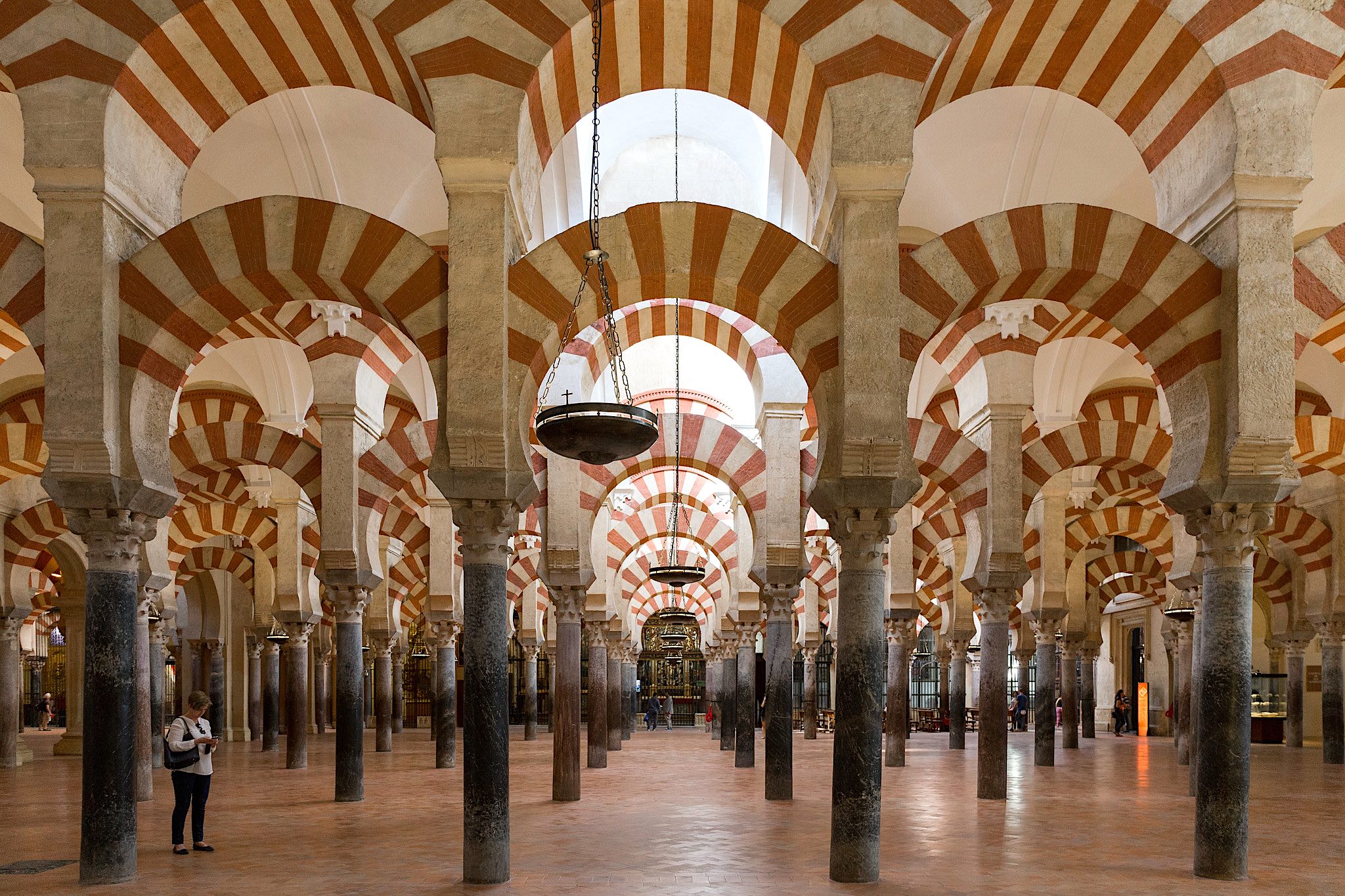
**Name:** Mosque of Cordoba
**Era:** Umayyad 650-750
**Location:** Cordoba, Spain
**Patron:** Abd al-Rahman I
**Significance:** Contains hypostyle halls, Visigothic arches, and Islamic prominence. Has a mihrab.
**Era:** Umayyad 650-750
**Location:** Cordoba, Spain
**Patron:** Abd al-Rahman I
**Significance:** Contains hypostyle halls, Visigothic arches, and Islamic prominence. Has a mihrab.
6
New cards
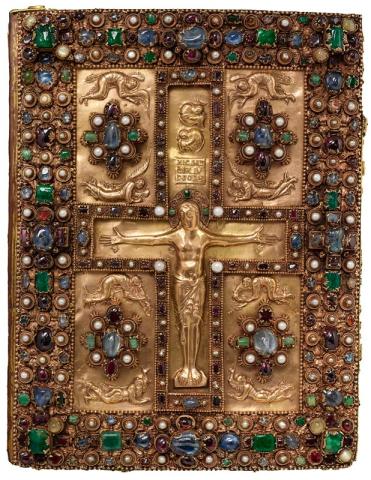
**Name:** Lindau Gospels (made in Austria)
**Era:** Carolingian-Ottonian 760-900
**Location:** Austria
**Significance:** depicts a triumphant Christ on the cross; jewels represent Heavenly Jerusalem and technological mastering of metal. Displays advanced filigree and repousse.
pearls: holy apostles
red jewels: Christ’s blood
blue jewels: heaven
**Era:** Carolingian-Ottonian 760-900
**Location:** Austria
**Significance:** depicts a triumphant Christ on the cross; jewels represent Heavenly Jerusalem and technological mastering of metal. Displays advanced filigree and repousse.
pearls: holy apostles
red jewels: Christ’s blood
blue jewels: heaven
7
New cards
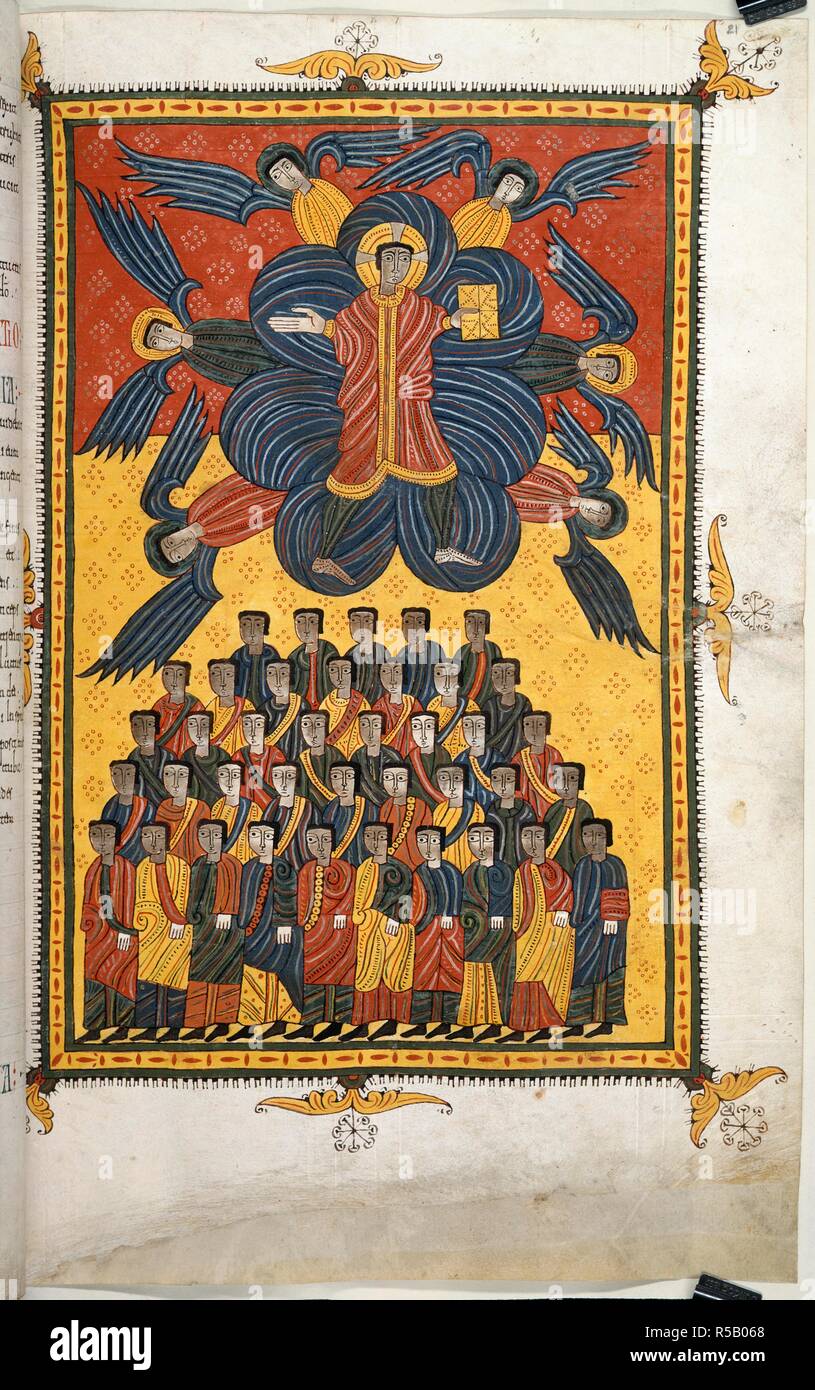
\
**Name:** Beatus of Liebana *Illustrated Commentary on the Apocalypse* (12 volumes) “Christ Appearing in the Clouds”
**Era:** Romanesque 1000-1150
**Location:** Santo Domingo, Silos
**Makers:** Munnio and Dominico
**Significance:** Represents the book of revelation and depicts the second coming of Christ. Displays local color and isocephaly
**Era:** Romanesque 1000-1150
**Location:** Santo Domingo, Silos
**Makers:** Munnio and Dominico
**Significance:** Represents the book of revelation and depicts the second coming of Christ. Displays local color and isocephaly
8
New cards
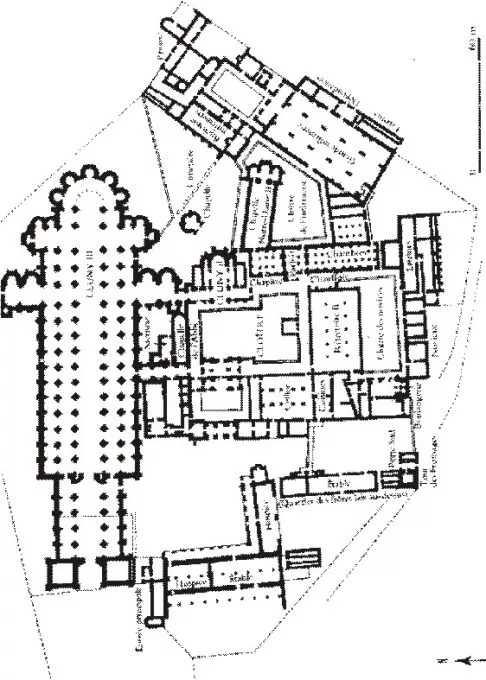
\
**Name:** Plan of the Abbey of Cluny
**Era:** Romanesque 1000-1150
**Location:** Cluny, France
**Significance:** Has a double transept (sign of power, excess), radiating chapels, relics, altars, basilica-like plan, distinct geometric form, huge cloister, and monastic complex. Cluny III was the largest church until St. Peters was rebuilt.
**Era:** Romanesque 1000-1150
**Location:** Cluny, France
**Significance:** Has a double transept (sign of power, excess), radiating chapels, relics, altars, basilica-like plan, distinct geometric form, huge cloister, and monastic complex. Cluny III was the largest church until St. Peters was rebuilt.
9
New cards
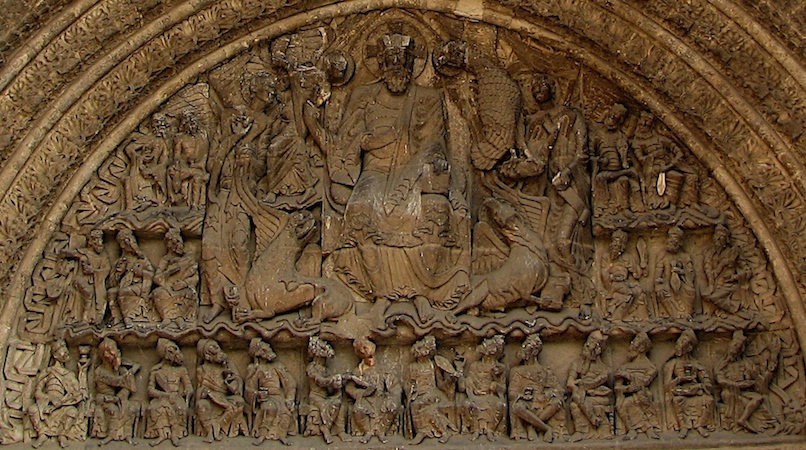
\
**Name:** Christ in Majesty (on tympanum)
**Era:** Romanesque 1000-1150
Location: St. Pierre, Moissac, France
**Significance:** Hieratic scale. Depicts Christ surrounded by 4 beasts and 24 elders. Extremely detailed work: flowers and elders on the bottom are slightly different. Rise of monumental sculpture on the front of churches. Shift from (early Christian) Neoplatonism to extravagant exteriors, which is the church’s social control.
**Era:** Romanesque 1000-1150
Location: St. Pierre, Moissac, France
**Significance:** Hieratic scale. Depicts Christ surrounded by 4 beasts and 24 elders. Extremely detailed work: flowers and elders on the bottom are slightly different. Rise of monumental sculpture on the front of churches. Shift from (early Christian) Neoplatonism to extravagant exteriors, which is the church’s social control.
10
New cards

**Name:** Dancing Prophet/Jeremiah on trumeau
**Era:** Romanesque 1000-1150
**Location:** Saint-Pierre, Moissac
**Significance:** An elongated sculpture. The body is twisting and not naturalistic, with more artistic freedom (qualities typical of Romanesque sculptures).
**Era:** Romanesque 1000-1150
**Location:** Saint-Pierre, Moissac
**Significance:** An elongated sculpture. The body is twisting and not naturalistic, with more artistic freedom (qualities typical of Romanesque sculptures).
11
New cards
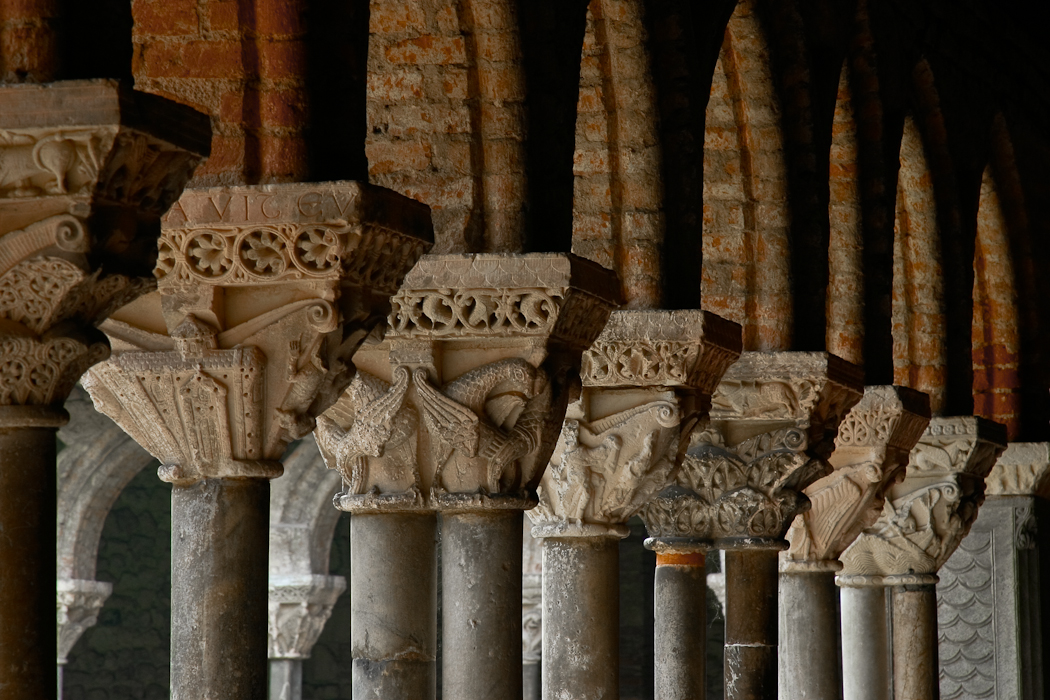
\
**Name**: Cloister Capitals
**Era:** Romanesque 1000-1150
**Location:** Saint Pierre, Moissac
**Significance:** Each capital is carved and decorated in a different way. Some have epitaphs. Typically display scenes from the old testament.
Some mentioned in class:
1. Daniel in the lion’s den
2. The heavenly Jerusalem
Used to display dedication and lavishness.
**Era:** Romanesque 1000-1150
**Location:** Saint Pierre, Moissac
**Significance:** Each capital is carved and decorated in a different way. Some have epitaphs. Typically display scenes from the old testament.
Some mentioned in class:
1. Daniel in the lion’s den
2. The heavenly Jerusalem
Used to display dedication and lavishness.
12
New cards
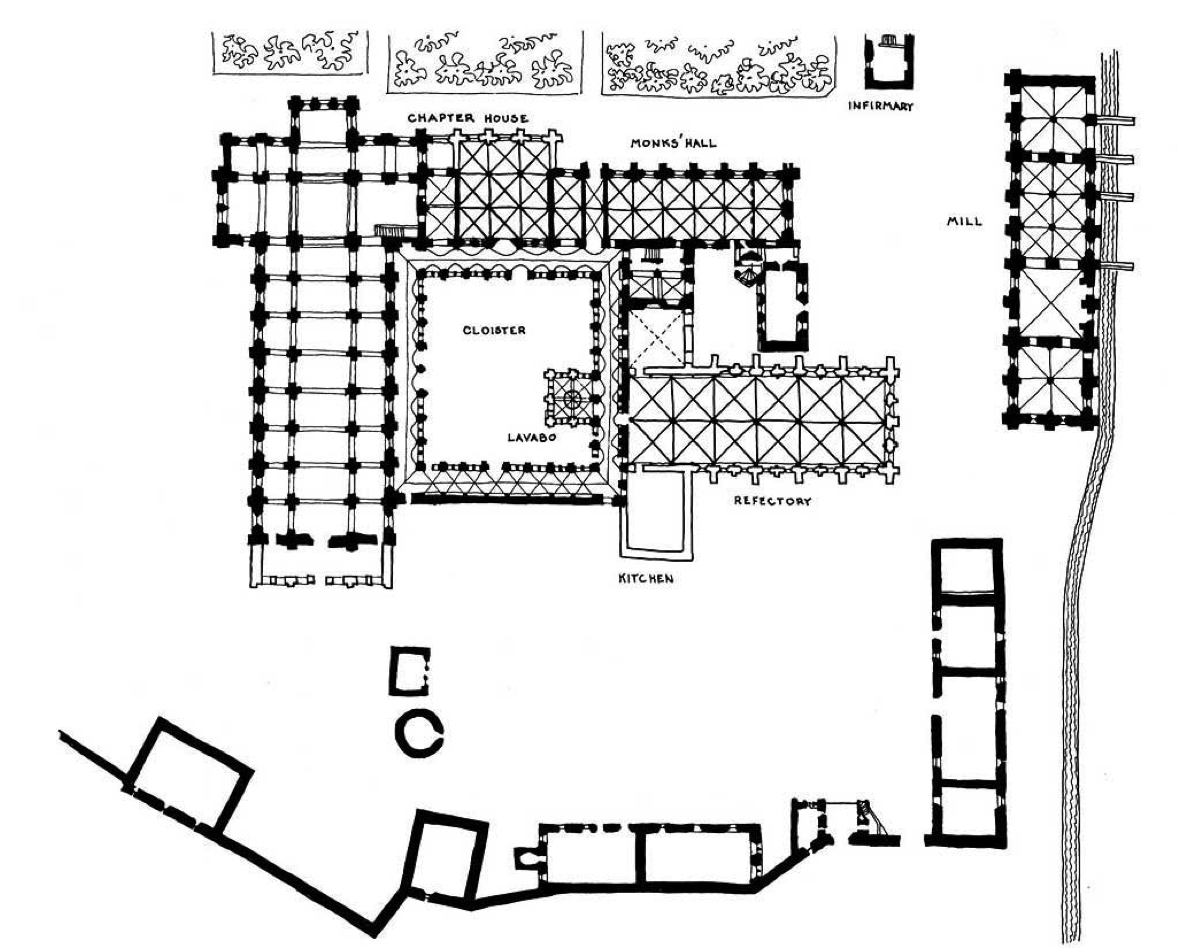
**Name:** Cistercian “Bernardine” Plan of the ideal monastery
**Era:** Romanesque 1000-1150
**Significance:** depicts a flat apse, denying excess decorations
**Era:** Romanesque 1000-1150
**Significance:** depicts a flat apse, denying excess decorations
13
New cards
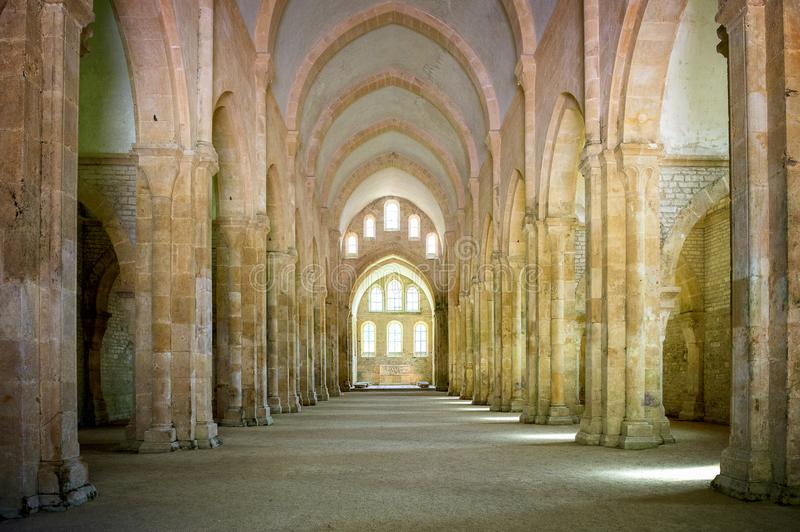
**Name:** Fontenay Abbey Church
**Era:** Romanesque 1000-1150
**Location:** Burgundy, France
**Founded by:** Bernard of Clairvaux
**Significance:** no fancy sculpture, very simple to reject greed and ostentation.
**Era:** Romanesque 1000-1150
**Location:** Burgundy, France
**Founded by:** Bernard of Clairvaux
**Significance:** no fancy sculpture, very simple to reject greed and ostentation.
14
New cards

**Name:** Virgin and Child
**Era:** Romanesque 1000-1150
**Location:** The Cloisters, Metropolitan Museum of Art
**Significance:** this goes back to Byzantine imagery. The concept of Jesus sitting on Mary’s lap is referred to as *The Throne of Wisdom*. Mary is stiff, playing a supporting role as the bearer of the child. Baby Jesus has a receding hairline to show wisdom, like Solomon from the old testament. Liquid-like, linear patterns of drapery, and stiff limbs.
**Era:** Romanesque 1000-1150
**Location:** The Cloisters, Metropolitan Museum of Art
**Significance:** this goes back to Byzantine imagery. The concept of Jesus sitting on Mary’s lap is referred to as *The Throne of Wisdom*. Mary is stiff, playing a supporting role as the bearer of the child. Baby Jesus has a receding hairline to show wisdom, like Solomon from the old testament. Liquid-like, linear patterns of drapery, and stiff limbs.
15
New cards
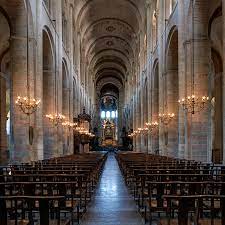
**Name:** Basilica of Saint-Sernin
**Era:** Romanesque 1000-1150
**Location:** Toulouse, France
**Significance:** Has two levels: a nave arcade and a gallery, round arches, barrel vault, transverse arch, and a bay unit. Bay unit: a unit marked between vertical lines or planes. Example: the space between two columns.
**Era:** Romanesque 1000-1150
**Location:** Toulouse, France
**Significance:** Has two levels: a nave arcade and a gallery, round arches, barrel vault, transverse arch, and a bay unit. Bay unit: a unit marked between vertical lines or planes. Example: the space between two columns.
16
New cards
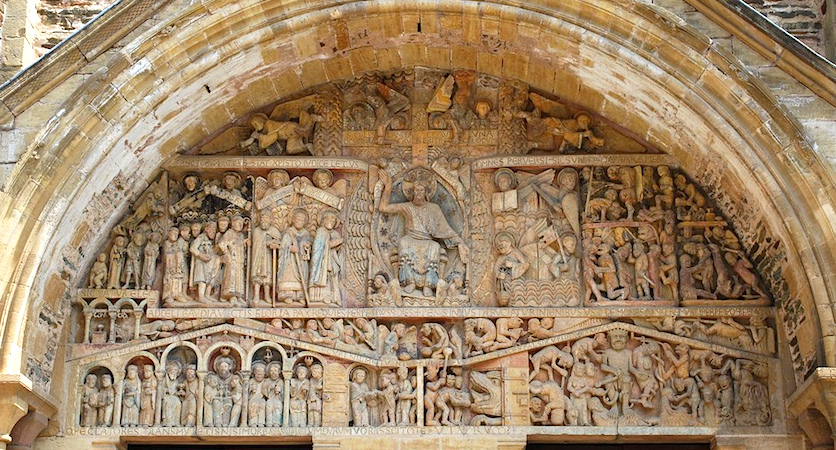
**Name:** Sainte-Foy Tympanum
**Era:** Romanesque 1000-1150
**Location:** Conques, France
**Significance:** depicts the last judgment and resurrection of the dead.
3rd layer: souls rise from their tombs
2nd layer: Christ in the center in the mandorla
1st layer: angels (?)
**Era:** Romanesque 1000-1150
**Location:** Conques, France
**Significance:** depicts the last judgment and resurrection of the dead.
3rd layer: souls rise from their tombs
2nd layer: Christ in the center in the mandorla
1st layer: angels (?)
17
New cards
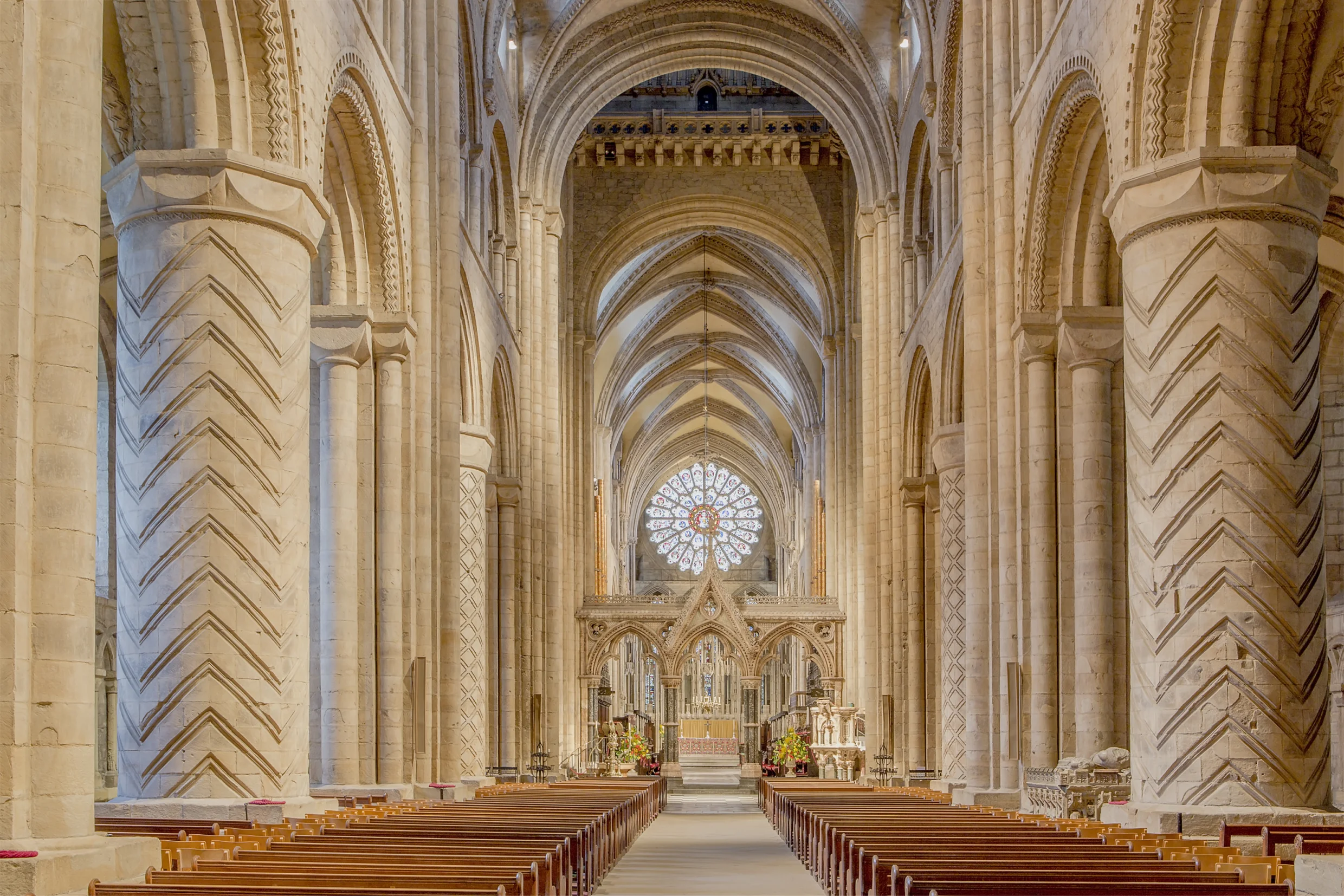
**Name:** Durham Cathedral
**Era:** Norman Romanesque 1066-1170
**Location:** Durham, English
**Architect:** Bishop William of Calais
**Significance:** Has twin towers, a German addition to westwork. Norman alternation: compound pier and column alternation. Superbay: a transverse arch and two nave arches per bay.
**Era:** Norman Romanesque 1066-1170
**Location:** Durham, English
**Architect:** Bishop William of Calais
**Significance:** Has twin towers, a German addition to westwork. Norman alternation: compound pier and column alternation. Superbay: a transverse arch and two nave arches per bay.
18
New cards

**Name:** Bayeux Tapestry
King Edward’s body is carried to St. Peter the Apostle + King Edward in bed speaks to his faithful after which he died
**Era:** Norman Romanesque 1066-1170
**Location:** Westminster Abbey, England
**Significance:** Based on the Norman conquest of England. 64 meters long. Made of linen, embroidered. Kind Edward: the main character, Anglo-Saxon king. Died of a stroke on Christmas day. The body is located in Westminster Abbey. These two sections of the story are told from right to left, contrary to the rest of the tapestry.
King Edward’s body is carried to St. Peter the Apostle + King Edward in bed speaks to his faithful after which he died
**Era:** Norman Romanesque 1066-1170
**Location:** Westminster Abbey, England
**Significance:** Based on the Norman conquest of England. 64 meters long. Made of linen, embroidered. Kind Edward: the main character, Anglo-Saxon king. Died of a stroke on Christmas day. The body is located in Westminster Abbey. These two sections of the story are told from right to left, contrary to the rest of the tapestry.
19
New cards
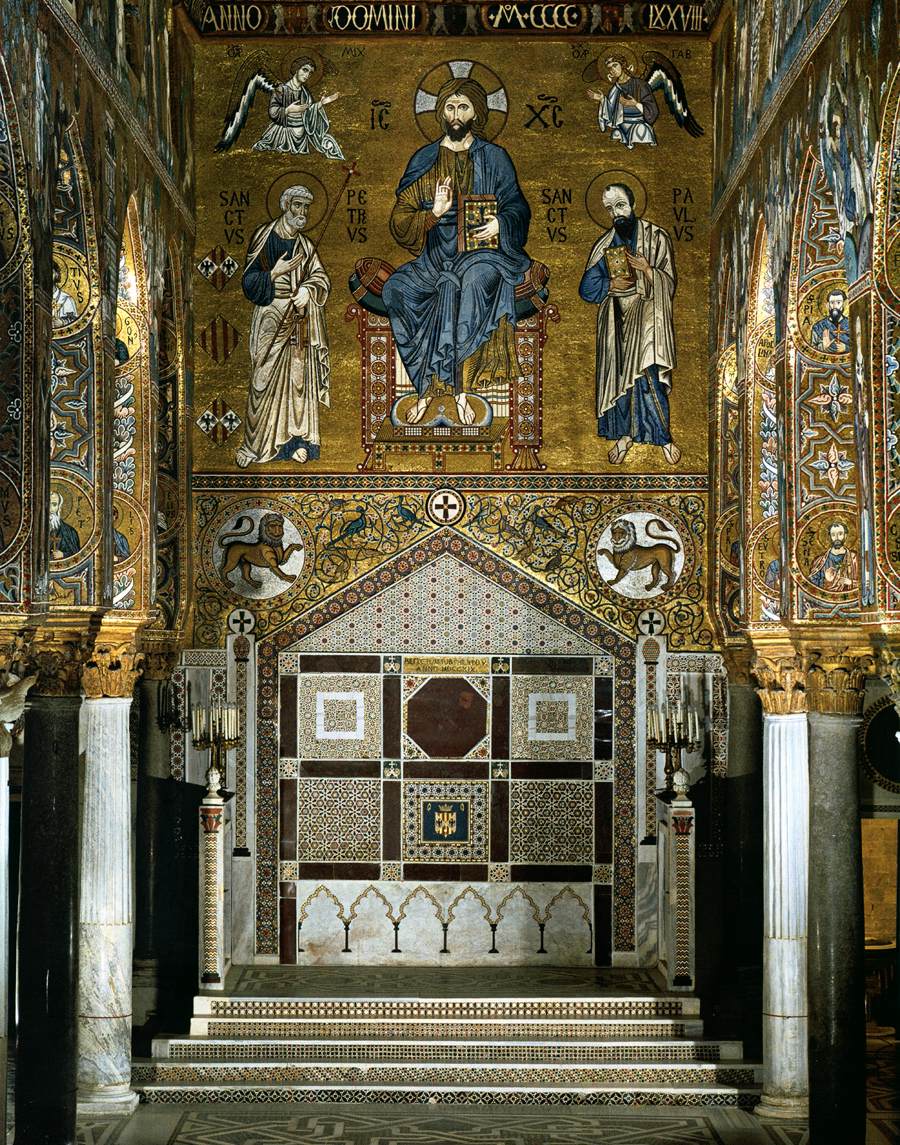
**Name:** Raised Throne of Roger II
**Era:** Norman Romanesque 1066-1170
**Location:** Capella Palatina in Palermo, Sicily
**Significance:** promotes the idea of spiritual power. Mosaic of Christ and apostles on top of the throne to show that they approve of his rule.
**Era:** Norman Romanesque 1066-1170
**Location:** Capella Palatina in Palermo, Sicily
**Significance:** promotes the idea of spiritual power. Mosaic of Christ and apostles on top of the throne to show that they approve of his rule.
20
New cards
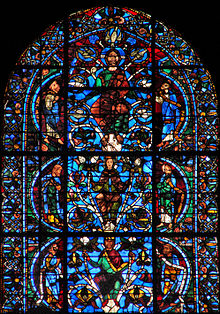
**Name:** Tree of Jesse Window
**Era:** Gothic 1140-1450
**Location:** Abbey Church of Saint-Denis (near Paris), France
**Significance:** A window about kingship stemming from an Old Testament subject coming from Isaiah. Jesse is seen as the basis for the dynasty of sacred rulers which make up Christ’s sacred lineage. Displays lilies, which are a reference to the French monarchy. Suger is represented in this window through amplificatio.
**Era:** Gothic 1140-1450
**Location:** Abbey Church of Saint-Denis (near Paris), France
**Significance:** A window about kingship stemming from an Old Testament subject coming from Isaiah. Jesse is seen as the basis for the dynasty of sacred rulers which make up Christ’s sacred lineage. Displays lilies, which are a reference to the French monarchy. Suger is represented in this window through amplificatio.
21
New cards
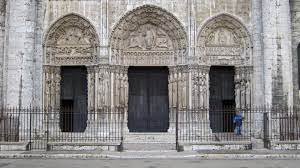
**Name:** Royal Portal
**Era:** Gothic 1140-1450
**Location:** Notre-Dame de Chartres, France
**Significance:** The royal portals depict Christ in Majesty, promoting the apocalypse, therefore reflecting the desire of the church to convert the secular laity that pass by the building. It also marks the rise of the cult of Mary where she is seen as an intercessor between one and Christ.
**Era:** Gothic 1140-1450
**Location:** Notre-Dame de Chartres, France
**Significance:** The royal portals depict Christ in Majesty, promoting the apocalypse, therefore reflecting the desire of the church to convert the secular laity that pass by the building. It also marks the rise of the cult of Mary where she is seen as an intercessor between one and Christ.
22
New cards

**Name:** St. Lubinus Window
**Era:** Gothic 1140-1450
**Location:** Window of Trades, Chartres Cathedral
**Significance:** Donated by the vintners, taverners, and wine-criers. It is part of the most complete set of stained-glass windows that exist from medieval cathedrals. Amplificatio is used as a narrative strategy. Shows shoemakers, bread makers, bankers (usurious act), etc.
**Era:** Gothic 1140-1450
**Location:** Window of Trades, Chartres Cathedral
**Significance:** Donated by the vintners, taverners, and wine-criers. It is part of the most complete set of stained-glass windows that exist from medieval cathedrals. Amplificatio is used as a narrative strategy. Shows shoemakers, bread makers, bankers (usurious act), etc.
23
New cards
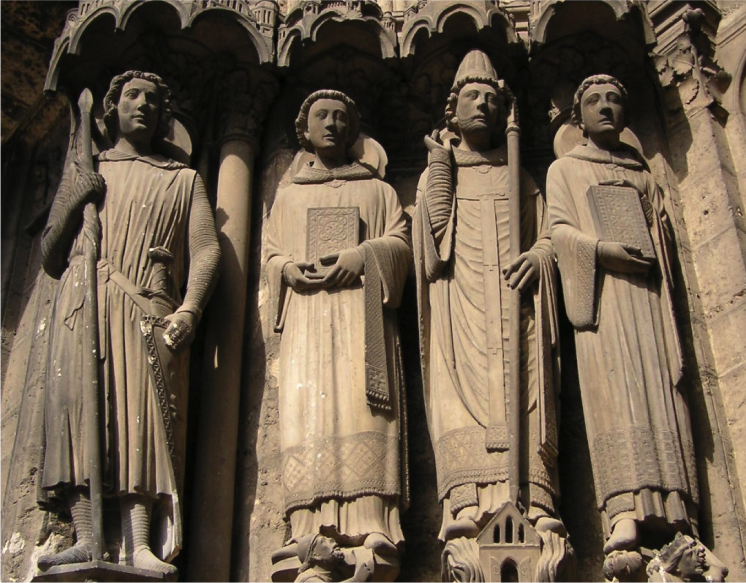
**Name:** South Transept Portal - Martyr’s Portal
**Era:** Gothic 1140-1450
**Location:** Notre-Dame de Chartres, France
**Significance:** These are the Jamb statues of Notre Dame of Chartres. It depicts Saint Theodore, Saint Stephen, Pope Clementine, and Saint Lawrence. All figures have been idealized, which is deduced from their haircuts which reflect the traditional style of the time.
**Era:** Gothic 1140-1450
**Location:** Notre-Dame de Chartres, France
**Significance:** These are the Jamb statues of Notre Dame of Chartres. It depicts Saint Theodore, Saint Stephen, Pope Clementine, and Saint Lawrence. All figures have been idealized, which is deduced from their haircuts which reflect the traditional style of the time.
24
New cards
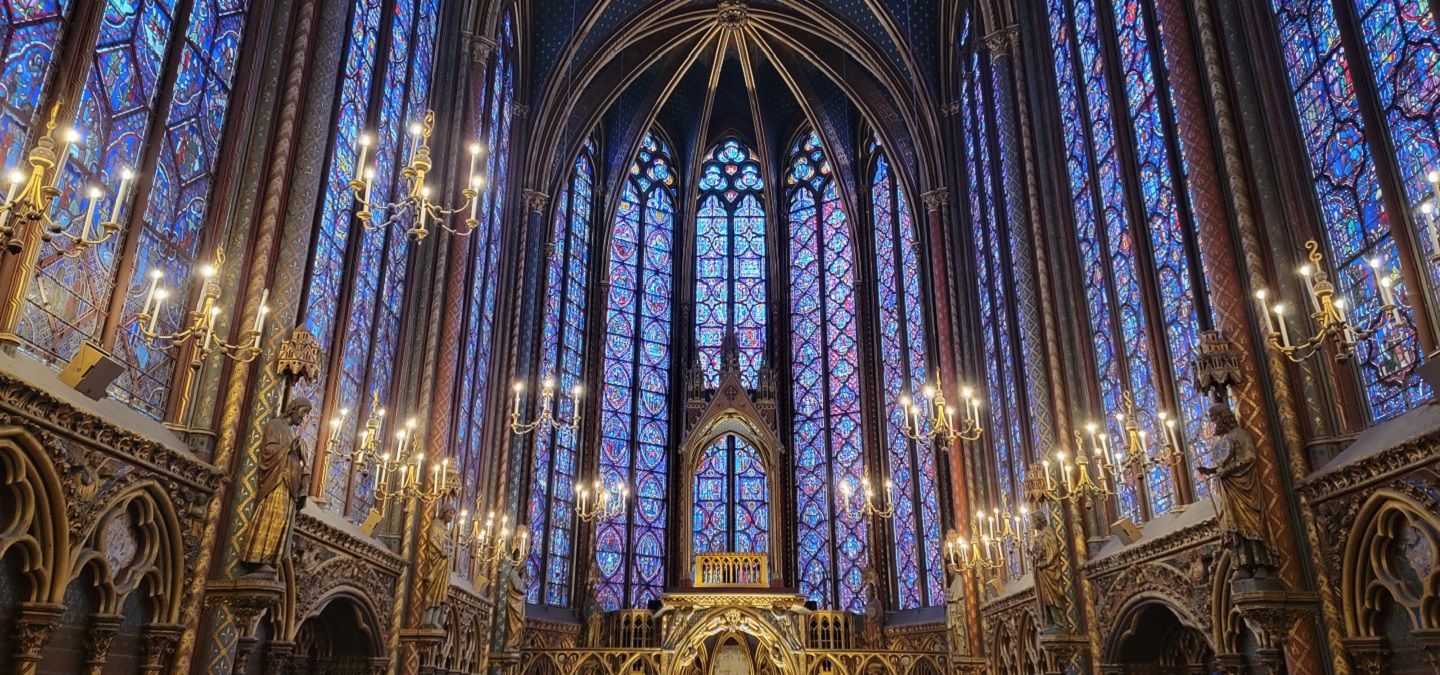
**Name:** Saint-Chapelle
**Era:** Gothic 1140-1450
**Location:** Paris, France
**Patron:** King Louis IX
**Significance:** The chapel has walls of stained-glass windows and a rose window. Paid for exclusively by the King for either political or pious reasons. The windows depict stories from the bible: Genesis, Exodus, Numbers, Deuteronomy, Judges, Isiah/Jesse, John, Passion, John, Jeremiah, Ezechiel, Esther, Judith, Kings, Royal, and Apocalypse in the rose window.
**Era:** Gothic 1140-1450
**Location:** Paris, France
**Patron:** King Louis IX
**Significance:** The chapel has walls of stained-glass windows and a rose window. Paid for exclusively by the King for either political or pious reasons. The windows depict stories from the bible: Genesis, Exodus, Numbers, Deuteronomy, Judges, Isiah/Jesse, John, Passion, John, Jeremiah, Ezechiel, Esther, Judith, Kings, Royal, and Apocalypse in the rose window.
25
New cards
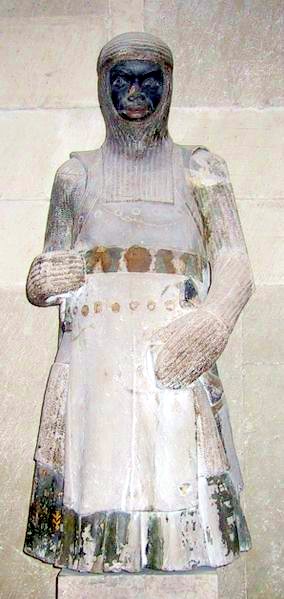
**Name:** St. Maurice
**Era:** Gothic 1140-1450
**Location:** Cathedral of Saints Maurice and Catherine in Magdeburg, Germany
**Significance:** This life-sized figure marks the beginning of racialized figures.
**Era:** Gothic 1140-1450
**Location:** Cathedral of Saints Maurice and Catherine in Magdeburg, Germany
**Significance:** This life-sized figure marks the beginning of racialized figures.
26
New cards
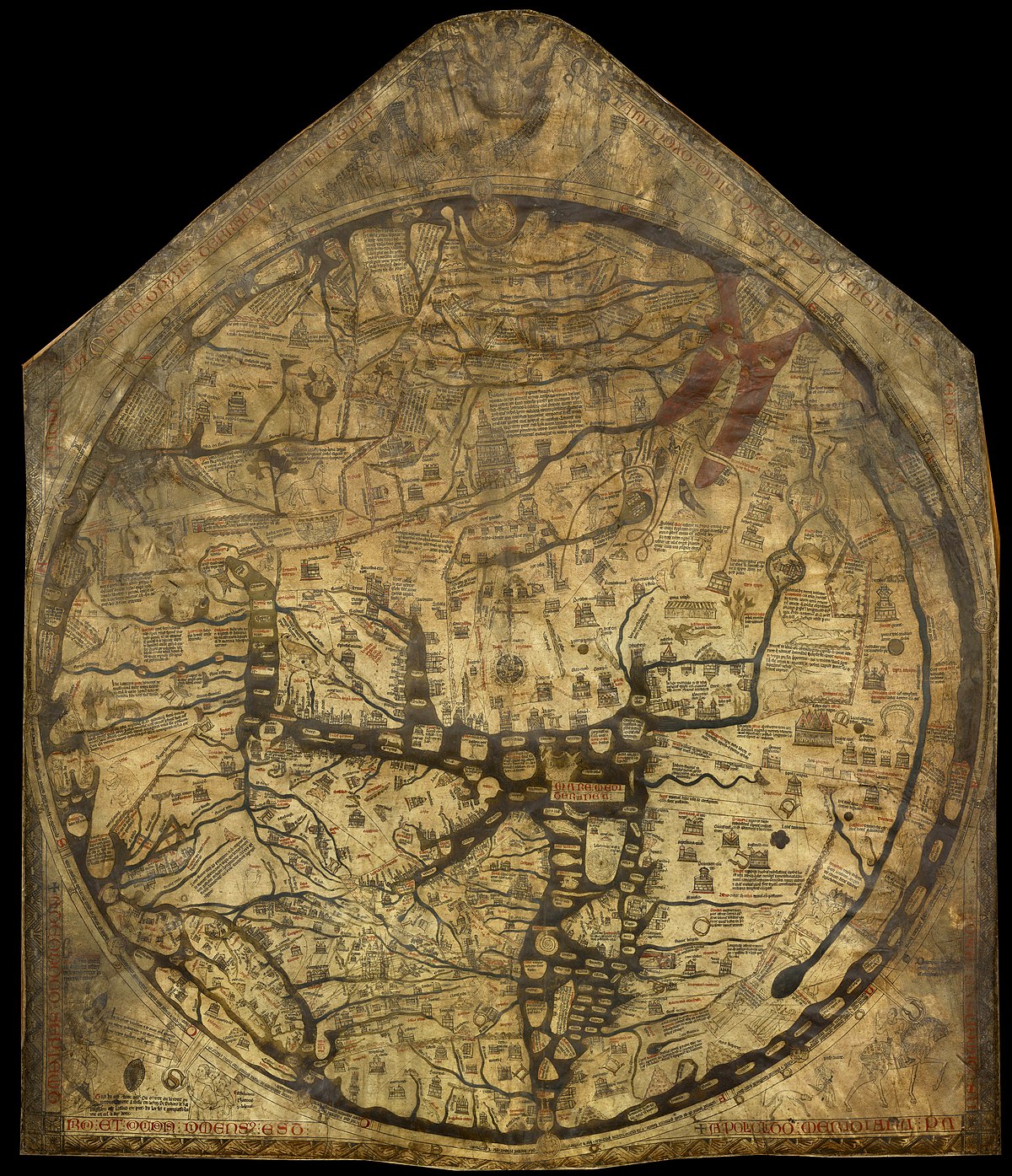
**Name:** The Hereford World Map “Mappa Mundi”
**Era:** Gothic 1140-1450
**Location:** England
**Significance:** Places a round depiction of Jerusalem at the center which opposes the biblical description of Jerusalem as square. Paris is scratched out. Alexander the Great’s conquests are displayed by a tent.
**Era:** Gothic 1140-1450
**Location:** England
**Significance:** Places a round depiction of Jerusalem at the center which opposes the biblical description of Jerusalem as square. Paris is scratched out. Alexander the Great’s conquests are displayed by a tent.
27
New cards
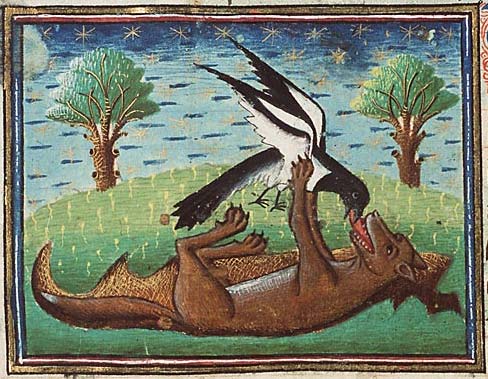
**Name:** Fox from Hugh of Fouilloy and William of Conches Bestiary
**Era:** Gothic 1140-1450
**Location:** Getty
**Significance:** Painted by Hugh of Fouilloy and William of Conches. Depicts the fox as an allusive animal that plays dead to trap its dinner, an anecdote that warns the audience to be wary of temptation and tricks. Images like this demonstrate a fascination with foreign animals and people.
**Era:** Gothic 1140-1450
**Location:** Getty
**Significance:** Painted by Hugh of Fouilloy and William of Conches. Depicts the fox as an allusive animal that plays dead to trap its dinner, an anecdote that warns the audience to be wary of temptation and tricks. Images like this demonstrate a fascination with foreign animals and people.
28
New cards
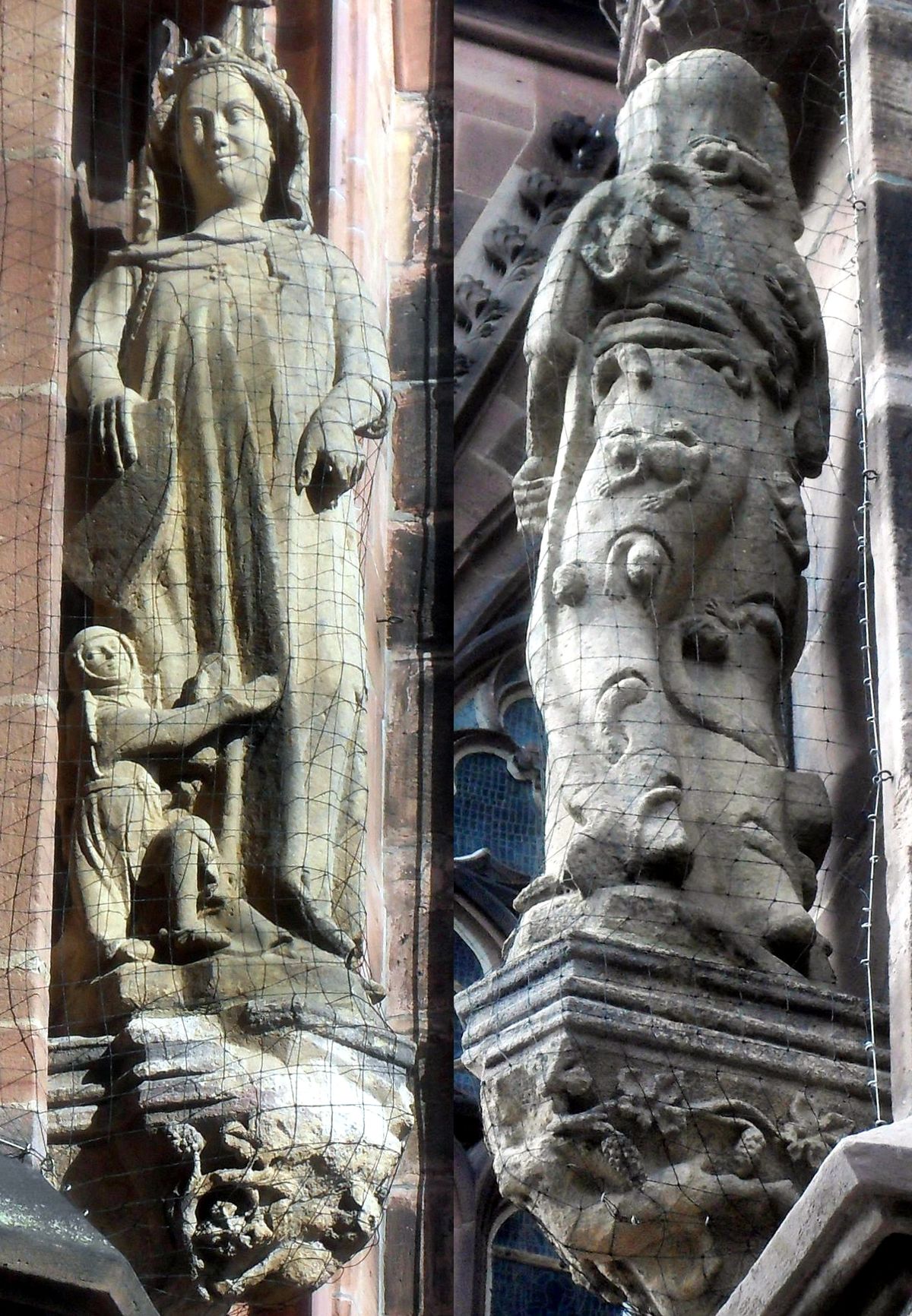
**Name:** Lady World
**Era:** Gothic 1140-1450
**Location:** Worms Cathedral South Portal
**Significance:** Is associated with the story of a knight devoted to a beautiful woman, which is symbolic of the world: beautiful in the front but full of horrors in the back. He eventually realizes that he is worshipping the world by giving in to his own desires and changes his lifestyle to please God.
**Era:** Gothic 1140-1450
**Location:** Worms Cathedral South Portal
**Significance:** Is associated with the story of a knight devoted to a beautiful woman, which is symbolic of the world: beautiful in the front but full of horrors in the back. He eventually realizes that he is worshipping the world by giving in to his own desires and changes his lifestyle to please God.
29
New cards
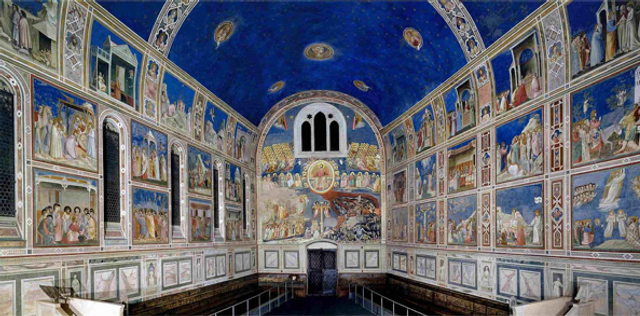
**Name:** Scrovegni Arena Chapel
**Era:** Gothic 1140-1450
**Location:** Padua, Italy
**Significance:** Shifts focus on Mary and depicts Christ as a son of a large and happy family. Images do not strictly follow the gospels. Instead, they vaguely follow biblical stories and two secular texts. Painted by Giotto and built by Scrovengi to atone for his sins as a banker.
**Era:** Gothic 1140-1450
**Location:** Padua, Italy
**Significance:** Shifts focus on Mary and depicts Christ as a son of a large and happy family. Images do not strictly follow the gospels. Instead, they vaguely follow biblical stories and two secular texts. Painted by Giotto and built by Scrovengi to atone for his sins as a banker.
30
New cards
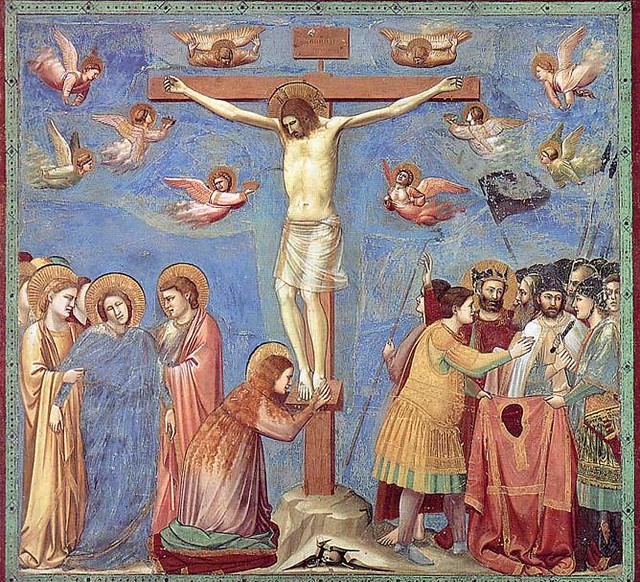
**Name:** *Crucifixion*
**Era:** Gothic 1140-1450
**Location:** Arena Chapel, Padua
**Significance:** Painted by Giotto. Crucifixion with a crowd instead of Christ in a monastery. Displays foreshortening
**Era:** Gothic 1140-1450
**Location:** Arena Chapel, Padua
**Significance:** Painted by Giotto. Crucifixion with a crowd instead of Christ in a monastery. Displays foreshortening
31
New cards
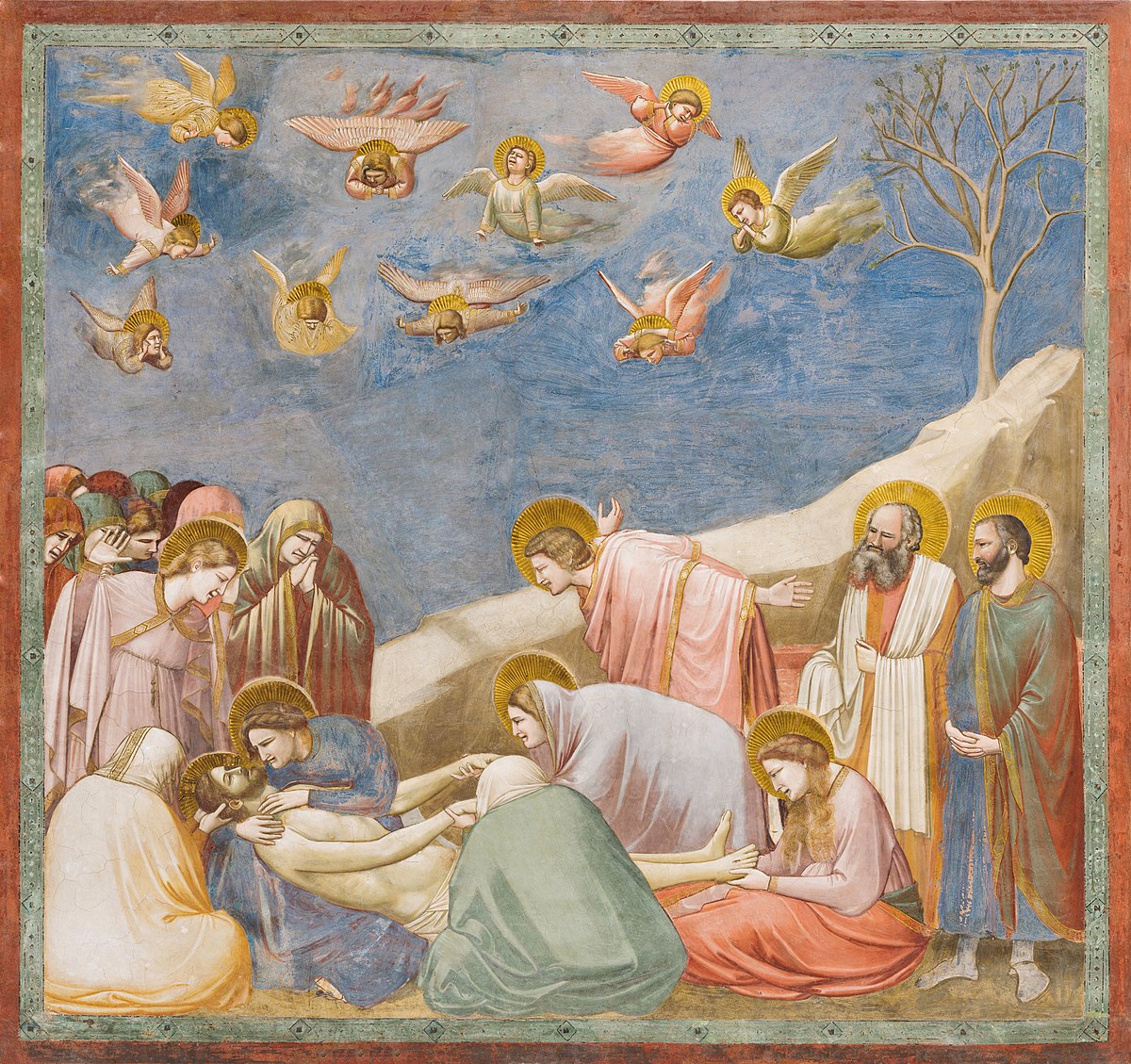
**Name:** *Lamentation*
**Era:** Gothic 1140-1450
**Location:** Arena Chapel, Padua
**Significance:** Painted by Giotto. A lamentation of Christ’s death. Giortto uses composition to draw your eye to the center of the scene: Mary lamenting Jesus’ death. The audience is invited to participate with the people in the painting; the audience becomes an extension of the painting because of the landscape which makes it seem like the audience is a part of the crowd
**Era:** Gothic 1140-1450
**Location:** Arena Chapel, Padua
**Significance:** Painted by Giotto. A lamentation of Christ’s death. Giortto uses composition to draw your eye to the center of the scene: Mary lamenting Jesus’ death. The audience is invited to participate with the people in the painting; the audience becomes an extension of the painting because of the landscape which makes it seem like the audience is a part of the crowd
32
New cards
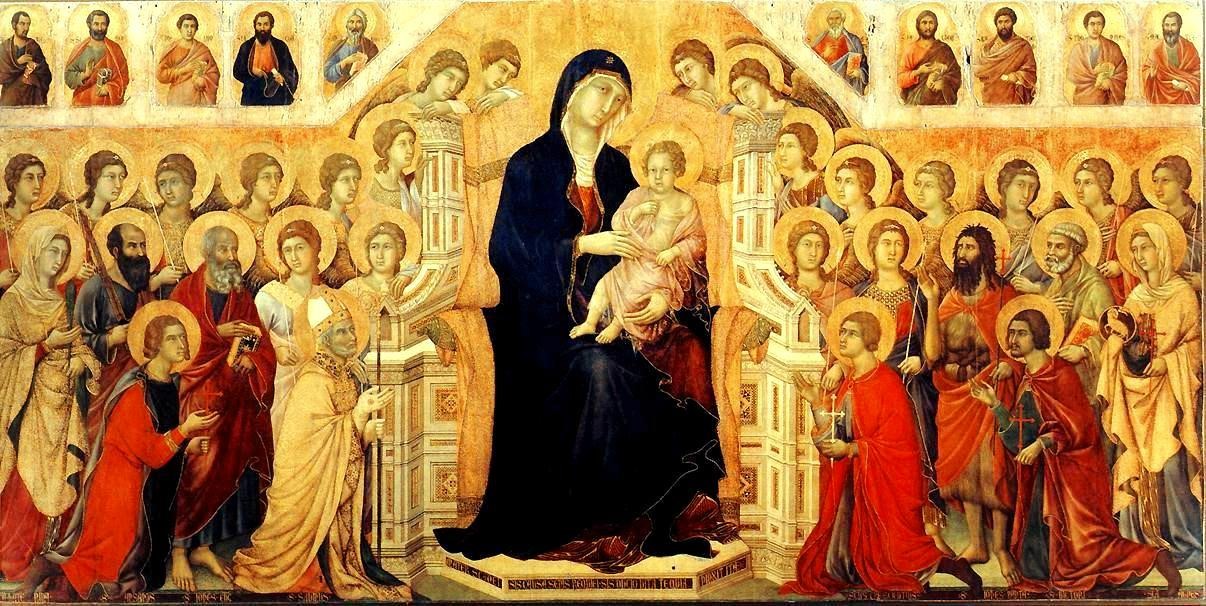
**Name:** Maesta (Duccio)
**Era:** Gothic 1140-1450
**Location:** Duomo di Siena
**Significance:** Extremely big painting, Byzantine-like. Lines defined the fabric instead of folds and shadows. The painting depicts scenes of the annunciation with Mary and Jesus surrounded by Saints (Catherine, Paul, Peter, Agnis, and John the Baptist) along with the patron Saints of Siena.
**Era:** Gothic 1140-1450
**Location:** Duomo di Siena
**Significance:** Extremely big painting, Byzantine-like. Lines defined the fabric instead of folds and shadows. The painting depicts scenes of the annunciation with Mary and Jesus surrounded by Saints (Catherine, Paul, Peter, Agnis, and John the Baptist) along with the patron Saints of Siena.
33
New cards
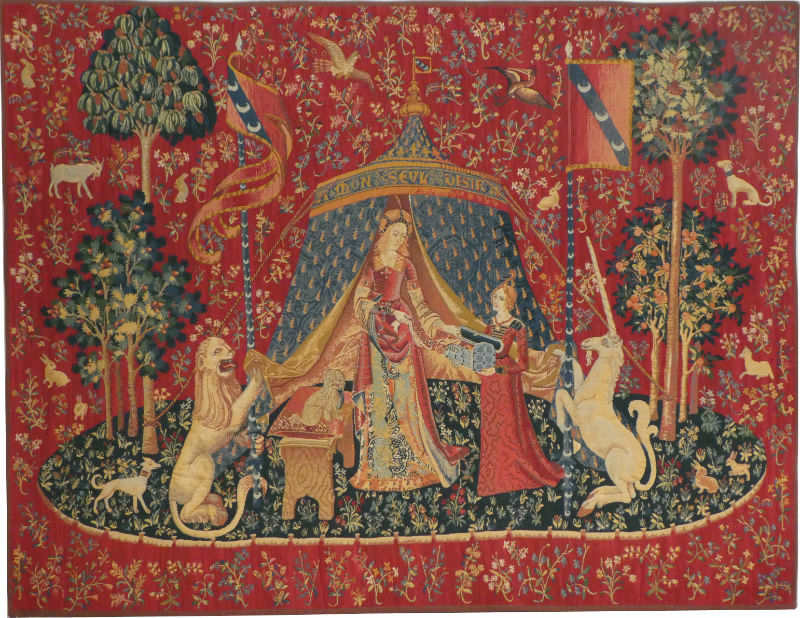
**Name:** *A mon seul desire*
**Era:** Gothic 1140-1450
**Location:** Musee National du Moyen-Age -- Theremes de Cluny (Paris)
**Significance:** About the senses: readable in many different ways. Could be conveying that people should overcome their senses and urges to get closer to God.
**Era:** Gothic 1140-1450
**Location:** Musee National du Moyen-Age -- Theremes de Cluny (Paris)
**Significance:** About the senses: readable in many different ways. Could be conveying that people should overcome their senses and urges to get closer to God.